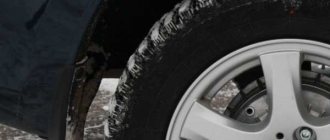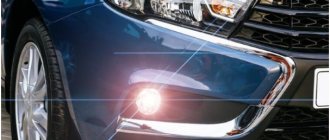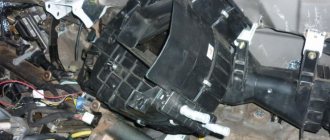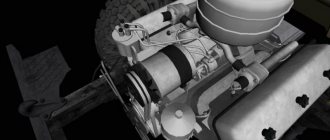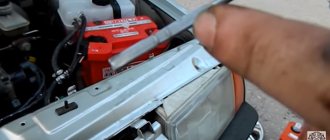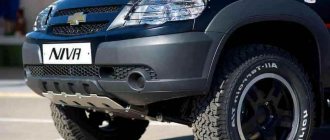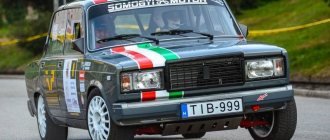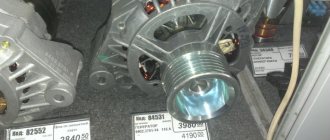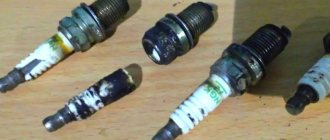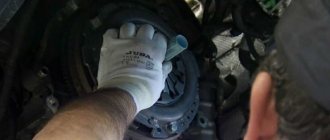- When replacement is required
- Is it possible to do the replacement yourself?
- What tools are needed?
- Removal stages
- Damage analysis
- Installation steps
- Useful video
In a VAZ-2114 car, the rear bumper is a decorative part that enhances the body. Its main component is plastic, easily destroyed by the slightest collision. A small accident and the owner of the brand is forced to think about how to remove the rear bumper on a VAZ-2114, what is required for this, and what to do with the damaged spare part. Let us consider possible nuances regarding the dismantling and subsequent installation of the structure.
Rear bumper VAZ 2114
In what cases is it necessary to replace the bumper?
The presented element performs a protective function for the vehicle body, therefore it takes on the bulk of the damage in a collision. With minor impacts, cracks and other defects appear on the product, which must be restored. However, in some cases, for example, after a serious accident, repairs are impractical and a new bumper must be installed. Among the reasons that necessitated this procedure:
- the protective element is completely destroyed;
- individual parts of the product are missing;
- through holes of a large area were formed.
In these situations, replacing the bumper is much more profitable and faster. This process includes several key steps:
- Assessment of the nature of damage.
- Dismantling elements that block access to the fasteners of the part.
- Removing the damaged bumper.
- Restoring the geometry of adjacent body elements.
- Installation of removed elements and new parts.
Our specialists have extensive experience in working with various brands and models of cars, so they replace the bumper as accurately, quickly and in strict accordance with factory regulations. The cost of work depends on several factors (the degree of damage, the price of new spare parts, etc.), therefore, it can only be clarified after a preliminary inspection.
Please note that experts do not recommend changing the bumper yourself. The lack of precise knowledge about the technology of work (especially in the presence of serious body defects) is fraught with broken geometry of parts, broken fasteners and other unpleasant consequences for the car owner.
Step-by-step instructions for bumper mount repair technology
To begin the repair, you need to remove the bumper.
To remove the front bumper you need:
- remove the radiator grille (for some car models - evaluate the need for this action on your own);
- where there are holes in the bumper for the towing cable, use a hexagon to find the heads of the mounting bolts and unscrew them;
- make sure that the arch protection is not screwed to the bumper (if so, unscrew them too);
- Carefully “tear” the part from the latches on the wings and remove it.
- carefully remove the rear light (evaluate the relevance of this action on your own);
- some car owners will have to remove the rear wheels (do not forget to place the car in a stable position on jacks or stands);
- under the lamp, as a rule, there are two bumper latches that need to be released;
- those fasteners that remain intact should be removed by unscrewing the plastic screws;
- only after all fastenings have been released can the bumper be removed (in some car models this is not required at all, since the resulting gap when removing the wheels and rear lights is enough to do the job yourself).
To remove the rear bumper:
Sometimes, instead of bolts, fastenings are held on by rivets. They must be carefully drilled out and removed by hand.
Removal and installation technology
Before starting work, it is very advisable to spray all threaded connections with WD 40. This should eliminate problems with soured bolts. If the car has rear fender liners and mudguards, they must be removed first. Having done this, you can begin to unscrew the screws securing it to the car body. In addition to these screws, which are usually located at the bottom, as a rule, there are also upper rear bumper mounting bolts. They may be covered by the trunk sealing rubber. We lift it and unscrew these bolts. In addition, there should be lower bolts. They can usually be located on the underside of the car. You should bend down and feel them with your hand first. If possible, it is better to drive the car onto an overpass or pit. Then these bolts can be seen. We turn them away too.
Now only the bumper mounting bracket prevents removal. More precisely, brackets. Carefully remove the part from engagement with them. We take it by one end and slowly pull it towards ourselves. From this, the end should move slightly to the side. We do the same on the other side. As a rule, there are no problems with this. After completing this procedure, you can remove the bumper, since nothing should hold it anymore. We pull the part towards us, gently rocking it from side to side.
When the bumper is removed, its plastic reinforcement becomes accessible, which is attached to the car. If replacing the bumper became necessary after it was damaged in an accident, then it is likely that this amplifier was also damaged. In this case, it will also have to be removed and replaced with a new one. It is attached to the body with bolts that are visible and accessible. As a rule, there are only three of them. One in the center, and two more on the sides. We turn them away. Then we pull the amplifier towards us and remove it from the car. Installation of parts occurs in reverse order.
It is worth noting that the front bumper mount is designed in approximately the same way. The procedure for removing it takes the same amount of time.
As can be seen from the above, replacing a bumper does not require special knowledge and skills, so even those who will be doing it for the first time should not worry. Almost nothing can be damaged or even broken. This takes little time, so there is no need to contact a car service center for help. You can also save money.
This is interesting: The operating principle of the automatic headlight leveler, the design of the device, installation and detailed connection diagram
Removing the rear bumper
Removing the rear bumper is also quite easy. Before starting work, you need to gain access to the fasteners. The easiest way to do this is in a sedan car. You just need to remove the carpet from the trunk, and access is open. Things are somewhat more complicated with a “station wagon”; in this case, sometimes you have to remove the entire rear trim, and remove the side trim from its mounts and move it to the side. Next, you can begin removing the bumper fasteners.
- We find the fixing bolts, insert a socket wrench with a 5-6 cm extension and unscrew all the fasteners one by one.
- We disconnect the clamps connecting the rear bumper and fender liners, which are located on both sides. Usually these are self-tapping bolts.
- We press on the element until it separates from the brackets located on the body, and carefully remove it, while lifting it.
The process of removing both elements is not labor-intensive, and even a beginner can do it. Now the protection element can be replaced with a new one, or the planned work can be carried out and the dismantled bumpers can be installed in their original places. The installation of these protective elements must be carried out carefully and slowly, otherwise you risk damaging the wings.
If you are an inexperienced motorist and are afraid of doing something wrong, you can always enlist the help of more experienced friends. Everything is not as complicated as it seems at first glance.
Reinstallation
Installing the rear bumper is done in the reverse order. Here it is also worth using the services of an assistant, since the rear bumper is also partially attached to plastic latches. In addition, during such reassembly, it is necessary to change gaskets, washers and other consumables in order to replace worn out accessories with new ones. Also be sure to thoroughly clean the damper mounting points from dirt and rust.
How to remove the rear bumper on a VAZ-2114, 2115
First you need to dismantle the fender liners. They are usually attached to self-tapping screws that need to be unscrewed with a screwdriver.
Removal occurs in several stages:
- Unscrew the 2 nuts (key “10”) securing the left cover.
Left pad fastening nuts
Attention! On Lada-2114 and 2115 cars, dismantling is identical, but on the sedan, in addition to all the steps, it is necessary to disconnect the license plate illumination terminals so that they are not damaged.
- Unscrew the screws on the left trim.
Left trim screws
- Dismantle it, first removing the studs.
Remove the left trim
- Removing the right one occurs in the same way.
- See which beam is installed. If it is made of metal (reinforced), you need to unscrew 3 nuts with a socket head “10”; on a plastic one, remove 2 screws that secure the product to the body, and 2 that hold the license plate.
Attaching the bumper to the body
- Carefully dismantle the part without damaging it.
Rear bumper parts
The bumper is removed together with the beam to install a new spare part. If the amplifier is made of plastic, you need to unscrew 6 screws and remove it, then on each side, using a socket head set to “13”, unscrew 3 nuts to remove the brackets. On a metal beam, the brackets are secured only with nuts.
What to do if fasteners are broken
Modern bumpers are equipped with parts made of plastic; they are the ones that most often break during various repair work, as well as in accidents. In the case where the fastening elements are broken, it is absolutely not necessary to buy a new damper; it is enough to repair them yourself.
When you have purchased new plastic latches, all you need to do is install them on the dismantled bumper. To do this, you first need to install a new ear of such a fastening. This element must be glued to the surface of the damper, then secured with self-tapping screws and then checked for reliability of the entire connection. In addition, fastening the shock-absorbing device latch on the inner surface can also be done using rivets.
This is interesting: Which product to choose to remove carbon deposits on piston rings
In the same case, when you could not find a suitable set of new latches, you will have to resort to handicraft production of such parts. Such a move is justified only in rare cases, since it is associated with a violation of the integrity of the damper, which can lead, in the future, to its rapid destruction. From a technical point of view, such a repair consists of cutting a rectangle of the required size from a sheet of metal. A hole is drilled in it for the mounting bolts that will now hold the bumper.
This is a barbaric method, so it is better to try to select standard fasteners in the kit. Such mounts do not have to be produced for a specific model; installation of suitable products from other cars is quite acceptable. This procedure ends with the installation of the bumpers in their original places.
Despite the fact that the car bumper mounts are made of fragile plastic, if they are properly dismantled and installed, they can be prevented from being damaged. In the same case, when this does happen, you can easily install new ones in their place. Thus, this element of the body structure will be restored and can serve you for a long time.
Features of installing tuning elements
Since most body kits significantly increase the mass of parts, the fasteners must be of the highest quality. You cannot use the cheapest materials for expensive tuning bumpers with a skirt.
The best way out is to contact a specialized service center. Experienced employees will be able to securely fasten the body kits, guaranteeing a long service life of the products.
After installing non-standard parts, you should check the rigidity of the fixation after some time. The peculiarity of tuning elements is that they are not always made of reliable materials. Therefore, the attachment points become loose.
Installation example:
Thus, following simple step-by-step instructions, you can not only remove and install bumpers if necessary, but also repair fasteners.
Did you manage to solve your problem using the recommendations from the article?
Yes!
46.4%
No. More answers required. I'll ask in the comments now.
37.75%
Partially. There are still questions. I'll write in the comments now.
15.85%
Voted: 347
Classification of fasteners
The bumper is the first protective element of the body. But it protects the structure of the car only conditionally. Manufacturers mainly install plastic parts. They are light in weight and can be removed and returned easily and quickly. There is one drawback - the plastic breaks at the slightest impact. The only thing that remains for manufacturers is to ensure reliable fixation of the part.
Bumpers can be installed in a variety of ways. As a rule, the fastening consists of separate elements and special slots for snapping into the grooves. Fastening pistons are widely used in cars of foreign brands.
Brackets
This sample most reliably fixes the product on the car body. Each manufacturer makes bumper mounting brackets according to its own unique design. They look like small elongated parts. The distinctive characteristics of the products are strength and durability. The elements can last for many years without breaking down even in conditions of poor-quality road surfaces. However, they also suffer in road accidents.
Brackets have been used by manufacturers of various car brands for a long time. This type of fasteners is most widespread in Europe, Russia and the USA.
Latches
Trying to minimize the cost of manufacturing vehicles, companies switched to a simpler type of fastener - latches. They are made from the same sheet of plastic as the bumper. The principle of quick-release fastening is that the part, thanks to the presence of special slots, is inserted into the grooves.
Advantages:
- No need to connect to the bumper.
- In case of serious damage, the entire structure is completely changed.
- Installation and dismantling is carried out in a matter of minutes.
Flaws:
- Fragility. The locking latches can break if one or more wheels fall into a large hole.
- Over time, the slots in the plastic wear out and the fastening weakens.
- Most motorists damage the latches during dismantling.
When purchasing a used car, be sure to pay attention to the specified bumper mounting parts. If the design of the machine specifically provides for latches, then with a high probability they have already been altered several times by the owner.
Self-tapping screws
The simplest and most cost-effective mounting option. It is used mainly on domestically produced cars. Screws are also used to secure bumpers on used foreign cars.
The method allows you to solve the problem of broken fasteners quickly and for a long time. However, this fastener has a huge disadvantage - it destroys the structure of the bumper. This applies not only to self-tapping screws, but also to factory fasteners. When using vehicles, a backlash is formed at the fixation points, which increases over time. Often the screws are unscrewed randomly, so owners have to constantly check the tightness of the fasteners.
This is interesting: How to wash injectors: washing methods, examples of cleaners
Bolts
Among experienced drivers, a bolt and nut is considered the best type of bumper fastening. Its effectiveness lies in its ease of maintenance. This type of fastening can be unscrewed at any time, the bumper can be removed and mounted back.
Another advantage is that the connection securely fixes the bumper for a long time.
Among the disadvantages, it should be noted that in some car models it is difficult to get to the bolts and nuts at the same time.
Original and analogues
If, when replacing many key elements, preference is often given to original parts, then the factory rear bumper is often replaced with cheaper analogues. This is due to the fact that the external parts of the body partly serve a decorative function. Therefore, less stringent requirements are imposed on the quality of such components. At the same time, you need to understand that by purchasing the original, you can get a part whose dimensions and connectors exactly match the design of the car.
The French manufacturer installs various bumpers on the Duster. The type of part and, accordingly, the article number are determined by the current configuration of the crossover. The initial modification uses a bumper with number 850229613R.
In the more expensive version, a part with article number 850220171R is installed.
On front-wheel drive versions without and with radar, different bumpers are used (original number 850220033R and 850228583R, respectively). A component with article number 850229219R or 850227892R is installed on the body of an all-wheel drive crossover.
Plastic bumper covers are available under numbers 850700752R and 850701407R. The article numbers also differ from each other if the part is supplemented with a bracket and an absorber.
Similar discrepancies are observed when it comes to analogues. Models with a plastic cover, installed on all modifications, with the exception of the maximum, are produced under the following articles:
- BLIC 5511-00-1305970P;
- PULO P2-DA-DUS1BS;
- DIEDERICHS 4560058;
- SCHLIECKMANN 779608;
- VAN WEZEL 1555509.
The maximum configuration of the Duster uses an analogue of the rear bumper with a plastic trim under the number SAT ST-RND1-087-A0. The model with an adsorber has the article number SAT ST-RND1-087R-0. If you use a Renault rear bumper bracket, then you need to purchase analogues with the same number, differing only in the numbers at the end: 087B-1 or 087B-2.
Features of repairing broken fasteners
If it is impossible to continue operating the vehicle, you should purchase new fastening materials or repair old parts.
The front bumper mounts are distinguished by their reliability. However, these retainers also require periodic repair. You can repair the bumper fasteners yourself. To do this, cut out a small rectangular plate from a sheet of strong metal and adjust the product to the required dimensions. After this, experts recommend making holes for the mounting bolts using small drills. The bolts will be located in these holes.
As a rule, this repair method is recommended to be used solely for the purpose of temporarily solving the problem. Ideally, you need to purchase a new product. If you can’t do without a “collective farm”, then you need to make the most reliable fasteners. Then you should begin installing the fixation lug. Installation is carried out using screws. After this, you can install the rivets.
Materials and tools needed for work
Before starting work, you should prepare everything that may be needed to remove the bumper and carry out repair work on its fastenings.
Make sure you have on hand:
- new mount (make sure they sell you a kit with a full set of mounts: 2 rear/front and 2 side);
- long hex key “6” (different car models may require the use of a different size key);
- crosshead screwdriver;
- 1-2 keys for “13”;
- lanterns;
- electric drill and drills (3 and 5/6/7 mm) (if you decide to make the mount yourself).
Damage analysis
Any emergency situation that results in the rear bumper coming into contact with an obstacle is a reason to remove the structure for damage analysis. It may seem that a small dent in the plastic is nothing to worry about, but it is not. Such little things often become the primary source of corrosion that spreads to the body part.
Therefore, it is better to remove the rear bumper on a VAZ-2114 car to assess the condition of the spare parts. Most minor damage can be easily repaired with putty and painting. In more serious cases, repair work becomes less cost-effective than replacement. Upon completion of the analysis, proceed with repairs or go to the store for a new product. The last stage awaits you - reassembling the bumper.
